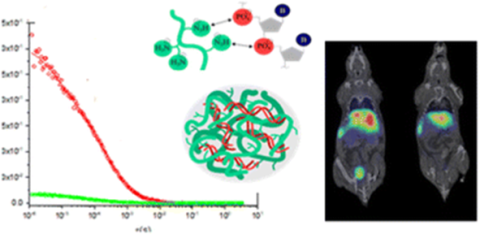A deeper knowledge on the formation and biological fate of polymer based gene vectors is needed for their translation into therapy. Here, polyplexes of polyethyleneimine (PEI) and silencing RNA (siRNA) are formed with theoretical N/P ratios of 2, 4 and 12. Fluorescence correlation spectroscopy (FCS) is used to study the formation of polyplexes from fluorescently labelled PEI and siRNA. FCS proves the presence of free PEI. From the analysis of the autocorrelation functions it was possible to determine the actual stoichiometry of polyplexes. FCS and fluorescence cross correlation spectroscopy (FCCS) are used to follow the fate of the polyplexes intracellularly. Polyplexes disassemble after 1 day inside cells. Positron emission tomography (PET) studies are conducted with radiolabelled polyplexes prepared with siRNA or PEI labelled with 2,3,5,6-tetrafluorophenyl 6-[18F]-fluoronicotinate ([18F]F-PyTFP). PET studies in healthy mice show that [18F]siRNA/PEI and siRNA/[18F]PEI polyplexes show similar biodistribution patterns with limited circulation in the bloodstream and accumulation in the liver. Higher activity for [18F]PEI in the kidney and bladder suggests the presence of free PEI.

11/04/2024
A study of complexation and biological fate of polyethyleneimine-siRNA polyplexes in vitro and in vivo by fluorescence correlation spectroscopy and positron emission tomography imaging
Title: A study of complexation and biological fate of polyethyleneimine-siRNA polyplexes in vitro and in vivo by fluorescence correlation spectroscopy and positron emission tomography imaging
Journal: Nanoscale, 2024. DOI: 10.1039/d3nr04026g
